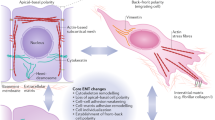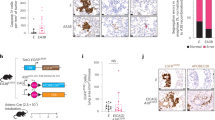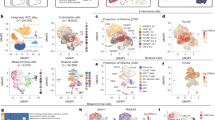Abstract
This study aims to investigate the significance of erythropoietin-producing hepatocellular (Eph)A2 expression and the mechanism by which EphA2 is involved in the epithelial–mensenchymal transition (EMT) of gastric cancer cells. EphA2 expression levels were upregulated and positively correlated with metastasis and EMT markers in human gastric cancer specimens. Modulation of EphA2 expression levels had distinct effects on cell proliferation, cell cycle, migration, invasion and morphology in the gastric cancer cell lines SGC7901 and AGS in vitro and in vivo. Overexpression of EphA2 resulted in the upregulation of the EMT molecular markers N-cadherin and Snail, as well as the Wnt/β-catenin targets TCF4, Cyclin-D1 and c-Myc, while silencing EphA2 using short hairpin RNA had the opposite effect. Furthermore, inhibition of the Wnt/β-catenin pathway by XAV939 negated the effect of EphA2 overexpression, whereas activation of the Wnt/β-catenin pathway by LiCl impaired the effect of the EphA2 knockdown on EMT. These observations demonstrate that EphA2 upregulation is a common event in gastric cancer specimens that is closely correlated with cancer metastasis and that EphA2 promotes EMT of gastric cancer cells through activation of Wnt/β-catenin signaling.
This is a preview of subscription content, access via your institution
Access options
Subscribe to this journal
Receive 50 print issues and online access
$259.00 per year
only $5.18 per issue
Buy this article
- Purchase on Springer Link
- Instant access to full article PDF
Prices may be subject to local taxes which are calculated during checkout






Similar content being viewed by others
References
Amit I, Wides R, Yarden Y . Evolvable signaling networks of receptor tyrosine kinases: relevance of robustness to malignancy and to cancer therapy. Mol Syst Biol 2007; 3: 151.
Sulman EP, Tang XX, Allen C, Biegel JA, Pleasure DE, Brodeur GM et al. ECK, a human EPH-related gene, maps to 1p36.1, a common region of alteration in human cancers. Genomics 1997; 40: 371–374.
Baeten CI, Hillen F, Pauwels P, de Bruine AP, Baeten CG . Prognostic role of vasculogenic mimicry in colorectal cancer. Dis Colon Rectum 2009; 52: 2028–2035.
Brannan JM, Dong W, Prudkin L, Behrens C, Lotan R, Bekele BN et al. Expression of the receptor tyrosine kinase EphA2 is increased in smokers and predicts poor survival in non-small cell lung cancer. Clin Cancer Res 2009; 15: 4423–4430.
Cui XD, Lee MJ, Yu GR, Kim IH, Yu HC, Song EY et al. EFNA1 ligand and its receptor EphA2: potential biomarkers for hepatocellular carcinoma. Int J Cancer 2010; 126: 940–949.
Li X, Wang L, Gu JW, Li B, Liu WP, Wang YG et al. Up-regulation of EphA2 and down-regulation of EphrinA1 are associated with the aggressive phenotype and poor prognosis of malignant glioma. Tumour Biol 2010; 31: 477–488.
Merritt WM, Kamat AA, Hwang JY, Bottsford-Miller J, Lu C, Lin YG et al. Clinical and biological impact of EphA2 overexpression and angiogenesis in endometrial cancer. Cancer Biol Ther 2011; 10: 1306–1314.
Yuan WJ, Ge J, Chen ZK, Wu SB, Shen H, Yang P et al. Over-expression of EphA2 and EphrinA-1 in human gastric adenocarcinoma and its prognostic value for postoperative patients. Dig Dis Sci 2009; 54: 2410–2417.
Tandon M, Vemula SV, Mittal SK . Emerging strategies for EphA2 receptor targeting for cancer therapeutics. Expert Opin Therap Targets 2011; 15: 31–51.
Udayakumar D, Zhang G, Ji Z, Njauw CN, Mroz P, Tsao H . EphA2 is a critical oncogene in melanoma. Oncogene 2011; 30: 4921–4929.
Yuan W, Chen Z, Wu S, Guo J, Ge J, Yang P et al. Silencing of EphA2 inhibits invasion of human gastric cancer SGC-7901 cells in vitro and in vivo. Neoplasma 2012; 59: 105–113.
Lu C, Shahzad MM, Wang H, Landen CN, Kim SW, Allen J et al. EphA2 overexpression promotes ovarian cancer growth. Cancer Biol Ther 2008; 7: 1098–1103.
Thiery JP, Acloque H, Huang RY, Nieto MA . Epithelial–mesenchymal transitions in development and disease. Cell 2009; 139: 871–890.
Huber MA, Kraut N, Beug H . Molecular requirements for epithelial–mesenchymal transition during tumor progression. Curr Opin Cell Biol 2005; 17: 548–558.
Voulgari A, Pintzas A . Epithelial–mesenchymal transition in cancer metastasis: mechanisms, markers and strategies to overcome drug resistance in the clinic. Biochim Biophys Acta 2009; 1796: 75–90.
Kalluri R, Weinberg RA . The basics of epithelial-–mesenchymal transition. J Clin Invest 2009; 119: 1420–1428.
Howard S, Deroo T, Fujita Y, Itasaki N . A positive role of cadherin in Wnt/beta-catenin signalling during epithelial–mesenchymal transition. PLoS One 2011; 6: e23899.
Sundaram MV . RTK/Ras/MAPK signaling. WormBook 2006;. 1–19.
Yuan W, Chen Z, Wu S, Ge J, Chang S, Wang X et al. Expression of EphA2 and E-cadherin in gastric cancer: correlated with tumor progression and lymphogenous metastasis. Pathol Oncol Res 2009; 15: 473–478.
Huber O, Bierkamp C, Kemler R . Cadherins and catenins in development. Curr Opin Cell Biol 1996; 8: 685–691.
Taddei ML, Parri M, Angelucci A, Bianchini F, Marconi C, Giannoni E et al. EphA2 induces metastatic growth regulating amoeboid motility and clonogenic potential in prostate carcinoma cells. Mol Cancer Res 2011; 9: 149–160.
Macrae M, Neve RM, Rodriguez-Viciana P, Haqq C, Yeh J, Chen C et al. A conditional feedback loop regulates Ras activity through EphA2. Cancer Cell 2005; 8: 111–118.
Menges CW, McCance DJ . Constitutive activation of the Raf-MAPK pathway causes negative feedback inhibition of Ras-PI3K-AKT and cellular arrest through the EphA2 receptor. Oncogene 2008; 27: 2934–2940.
Miao H, Wei BR, Peehl DM, Li Q, Alexandrou T, Schelling JR et al. Activation of EphA receptor tyrosine kinase inhibits the Ras/MAPK pathway. Nat Cell Biol 2001; 3: 527–530.
Pratt RL, Kinch MS . Activation of the EphA2 tyrosine kinase stimulates the MAP/ERK kinase signaling cascade. Oncogene 2002; 21: 7690–7699.
Zhang G, Njauw CN, Park JM, Naruse C, Asano M, Tsao H . EphA2 is an essential mediator of UV radiation-induced apoptosis. Cancer Res 2008; 68: 1691–1696.
Fukuyama R, Niculaita R, Ng KP, Obusez E, Sanchez J, Kalady M et al. Mutated in colorectal cancer, a putative tumor suppressor for serrated colorectal cancer, selectively represses beta-catenin-dependent transcription. Oncogene 2008; 27: 6044–6055.
Malanchi I, Peinado H, Kassen D, Hussenet T, Metzger D, Chambon P et al. Cutaneous cancer stem cell maintenance is dependent on beta-catenin signalling. Nature 2008; 452: 650–653.
Lovatt M, Bijlmakers MJ . Stabilisation of beta-catenin downstream of T cell receptor signalling. PLoS One 2010; 5: pii: e12794.
Song S, Mazurek N, Liu C, Sun Y, Ding QQ, Liu K et al. Galectin-3 mediates nuclear beta-catenin accumulation and Wnt signaling in human colon cancer cells by regulation of glycogen synthase kinase-3beta activity. Cancer Res 2009; 69: 1343–1349.
Wang Q, Sun ZX, Allgayer H, Yang HS . Downregulation of E-cadherin is an essential event in activating beta-catenin/Tcf-dependent transcription and expression of its target genes in Pdcd4 knockdown cells. Oncogene 2010; 29: 128–138.
Acknowledgements
This work was supported by Nature Scientific Foundation of China (81172297), Ministry of Education (NCET-11-0520, SRF for ROCS) and Hunan Province Natural Sciences Foundation of China (B2010-010). We thank Yangchun Xie and Liyang Zhang for their technical help.
Author information
Authors and Affiliations
Corresponding author
Ethics declarations
Competing interests
The authors declare no conflict of interest.
Additional information
Supplementary Information accompanies this paper on the Oncogene website
Supplementary information
Rights and permissions
About this article
Cite this article
Huang, J., Xiao, D., Li, G. et al. EphA2 promotes epithelial–mesenchymal transition through the Wnt/β-catenin pathway in gastric cancer cells. Oncogene 33, 2737–2747 (2014). https://doi.org/10.1038/onc.2013.238
Received:
Revised:
Accepted:
Published:
Issue Date:
DOI: https://doi.org/10.1038/onc.2013.238
Keywords
This article is cited by
-
Eph receptors and ephrins in cancer progression
Nature Reviews Cancer (2024)
-
Wnt3a is a promising target in colorectal cancer
Medical Oncology (2023)
-
Cell-cell contact-driven EphB1 cis- and trans- signalings regulate cancer stem cells enrichment after chemotherapy
Cell Death & Disease (2022)
-
Interactions between EGFR and EphA2 promote tumorigenesis through the action of Ephexin1
Cell Death & Disease (2022)
-
Cancer nanotechnology: current status and perspectives
Nano Convergence (2021)



